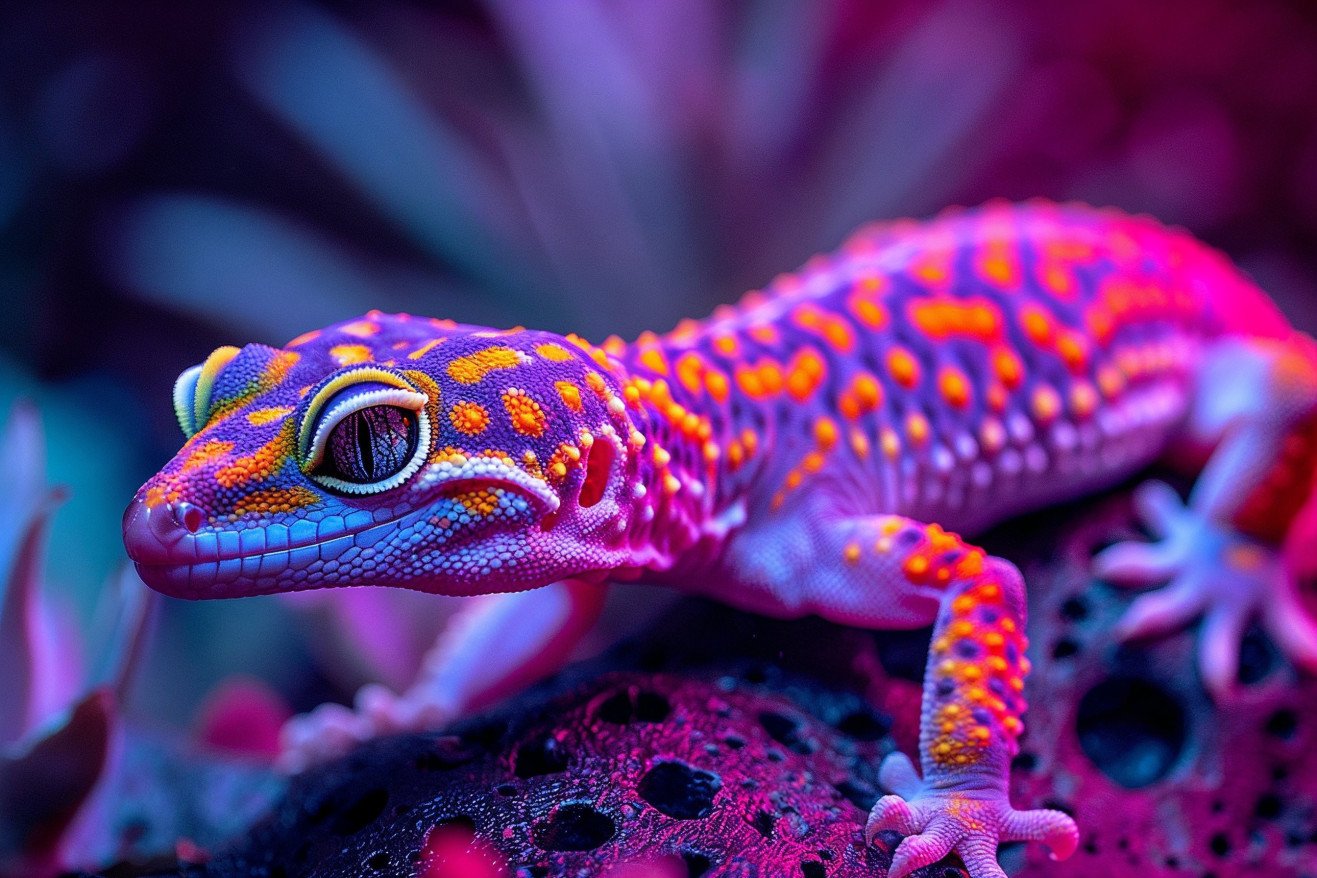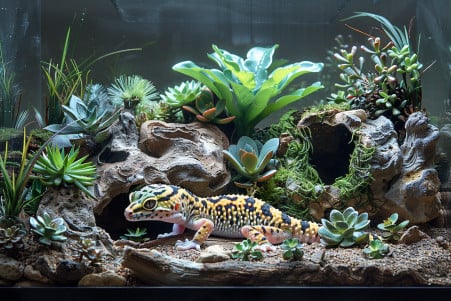Do Leopard Geckos Need UVB Lighting? Essential Care Guide
5 March 2024 • Updated 4 March 2024

If you’re a leopard gecko owner, you know that one of the most important things you can do for your pet is to make sure that you have their lighting needs down pat.
While leopard geckos don’t need UVB lighting if they’re getting the right amount of D3 in their diet, providing a low level of UVB can help them in several ways, including staying true to their natural environment, helping with vitamin D3 synthesis, and preventing metabolic bone disease.
Our in-depth investigation will take a deep dive into herpetological research, vet advice, and reptile care standards to give you a comprehensive understanding of whether or not leopard geckos need UVB lighting.
With this investigation, we’ll look at the importance of UVB for reptiles, the efficacy of dietary D3 supplementation, and how leopard geckos react to different lighting situations. This way, you can make sure that you’re setting up the best possible situation for your leopard gecko.
Do leopard geckos need UVB lighting?
Leopard Gecko Natural Habitat and Behavior
Leopard geckos are native to the dry, rocky deserts of South-Central Asia, including regions of Afghanistan and India, according to the San Diego Zoo. They are well adapted to living in areas with limited vegetation and water and a substrate that is made up of rock, compacted sand, and clay-gravel soil, not loose sand as is often shown, according to PetHelpful.
Leopard geckos are crepuscular, which means they are most active during twilight hours—dawn and dusk. This suggests that leopard geckos may have some UV exposure in the wild, although it is likely limited since they prefer to stay in shaded areas or burrows during the brightest part of the day, according to the San Diego Zoo.
The Spruce Pets explains that while leopard geckos don’t get direct exposure to high levels of UVB in the wild, some researchers believe that a small amount of UVB exposure may be helpful to them in captivity.
The fact that leopard geckos get indirect UVB exposure in the wild raises questions about how much UVB exposure they need in captivity. It’s important to know how reptiles produce vitamin D3 when they are exposed to UVB light and how this impacts leopard gecko health, including their calcium absorption and use and their overall health.
UVB and Reptile Vitamin D3 Synthesis
Reptiles, including leopard geckos, produce vitamin D3 in response to UVB exposure. This is important for regulating calcium and ensuring proper bone growth and development, as well as preventing metabolic bone disease (MBD).
A study in ScienceDirect found that exposing juvenile leopard geckos to low levels of UVB and supplementing them with dietary vitamin D3 led to higher blood vitamin D3 metabolite levels than those not exposed to UVB, indicating that leopard geckos can produce vitamin D3 in response to UVB.
In contrast, a study published in PubMed found that while UVB lighting led to some vitamin D3 production in bearded dragons, another popular reptile pet, the levels produced under typical captive conditions were lower than those in the wild. This shows how difficult it can be to recreate wild conditions and also indicates that UVB exposure may have some benefits for pet reptiles.
These studies indicate that while leopard geckos can get enough vitamin D from their diet, UVB lighting may have other physiological benefits that could improve their health and welfare. This is an area that’s worth exploring for reptile keepers who want to make sure they’re providing their pets with the most natural and healthy environment.
Vitamin D3 and Calcium in the Leopard Gecko Diet
Leopard geckos have a diverse diet in the wild that provides them with a variety of nutrients. In captivity, it can be difficult to ensure that they get all of the nutrients they need, especially when it comes to calcium and vitamin D3. These two vitamins are essential for bone health and metabolic function.
As a result, Terrarium Quest explains that leopard geckos need both a multivitamin and a calcium supplement. The calcium supplement is often combined with vitamin D3 to help the gecko’s body absorb the calcium, which is more in line with their natural diet.
Leopard geckos are able to get the vitamin D3 they need from their supplements, so they don’t need UVB lighting. However, PetMD warns that if leopard geckos are given too much vitamin D3, it can lead to metabolic bone disease (MBD), a condition that results from a lack of calcium.
To prevent this, Terrarium Quest suggests that keepers offer calcium in a dish so that the geckos can regulate their own intake.
They also suggest that keepers use calcium with vitamin D3 only occasionally to prevent overdosing, which can lead to organ failure.
Online Geckos also suggests gut loading feeder insects to ensure that leopard geckos eat prey that’s nutritious and hydrating, which can help supplement their diet. However, it’s important to note that keepers often have to dust these insects with vitamin and mineral powders before feeding them to the leopard geckos to ensure that they get the nutrients they need.
It’s clear that keeping leopard geckos healthy is a balancing act. While over-supplementation can be dangerous, a well-managed diet can help prevent MBD and other health problems. As we learn more about the impact of diet on leopard geckos, we also learn more about how their diet can impact their behavior and how their behavior can indicate their overall health and well-being.
How Light Affects Leopard Gecko Behavior
The relationship between light and leopard gecko behavior is an important topic for herpetologists and pet owners alike. Studies have shown that leopard geckos, which are crepuscular animals, can change their activity levels and stress responses based on the type of light they are exposed to.
For example, a study mentioned on PMC found that leopard geckos can follow the gaze of other leopard geckos, showing that they are responsive to visual stimuli, including light.
While there are few studies that directly look at how leopard geckos respond to UVB light, their visual communication and UV coloration have been studied, and as noted on ScienceDirect, it has been found that leopard geckos have UV-sensitive cones in their retinas. This means that their response to UVB light could be influenced by this adaptation, which could have implications for their well-being.
The hierarchical model of leopard gecko locomotion proposed by Integrative and Comparative Biology also shows that the photic environment, including UVB light, is important to leopard geckos’ daily activities.
The changes in leopard gecko behavior that have been observed in response to different light conditions could indirectly show the benefits or drawbacks of UVB light. It is important to understand these responses so that leopard geckos can be properly cared for in captivity and their well-being can be ensured.
While more research is needed to make firm conclusions, the research that has been done so far suggests that UVB light is likely to be important to leopard geckos’ overall health.
How to Create the Best Leopard Gecko Habitat with UVB Lighting
Creating a habitat that is as close to a leopard gecko’s natural environment as possible is important for the animal’s overall health and well-being.
When it comes to adding UVB lighting to the habitat, there are a number of things you can do to make sure the habitat is as beneficial as possible.
It is recommended to use fixtures like the Arcadia Shade Dweller or ZooMed 5% T5 linear UVB for standard morphs to provide a UV Index (UVI) that is appropriate for leopard geckos. Make sure to position the bulbs in a way that the terrarium’s decor won’t block them, and keep in mind that glass and thick screens can filter out UVB rays.
It is also important to make sure that you are able to monitor and adjust the UVB levels in the habitat to make sure that they are as beneficial as possible for your gecko.
Based on the advice of Leopard Gecko experts, it is important to watch your gecko’s behavior to see if it is showing signs that the UVB levels are working for it. You can then adjust the placement and duration of the UVB source to make sure that your gecko is able to bask during the peak hours of dawn and dusk.
At the same time, make sure that you are using dietary supplementation in conjunction with your UVB setup. While UVB light helps with D3 synthesis, it is still important to make sure that your gecko is getting a well-rounded diet. It is noted that it is important to make sure that you are providing calcium supplements that include vitamin D3 to make sure that the D3 is absorbed and used properly.
It is also important to make sure that you are balancing UVB exposure with other habitat elements like temperature gradients and hiding spaces. It is recommended that you also include an overhead heat source to help with digestion and that the habitat includes humid hides, as the right humidity is important for shedding and hydration.
By making sure that all of these elements are in place, you can make sure that the habitat you create for your leopard gecko not only supports its physical well-being but also its natural instincts and behaviors.
In Conclusion: The UVB Controversy in Leopard Gecko Husbandry
While the use of UVB lighting in leopard gecko husbandry has been controversial among experts, our investigation has shed some light on the topic.
Although leopard geckos are crepuscular and therefore don’t need UVB lighting due to their nocturnal lifestyle and ability to get vitamin D3 from their diet, research cited by The Spruce Pets shows that exposure to low levels of UVB light can help increase vitamin D3 levels, which in turn can help increase bone density and immune system function.
Meanwhile, Zen Habitats notes that while UVB lighting is not necessary, leopard geckos can benefit from it. This is further supported by The Reptile Centre, which recommends specific UVB lighting systems to help ensure a healthy day-night cycle and promote basking. Meanwhile, if UVB lighting is not used, it’s important to ensure that dietary supplementation is used, but it’s also important to make sure that it’s not overused.
In the end, the best leopard gecko husbandry practices will likely involve a combination of UVB lighting and dietary supplementation. Whether or not UVB lighting is used, the best approach will be one that is well-informed and takes into account the unique needs and behaviors of these animals, which will ensure that they are happy and healthy in captivity.


